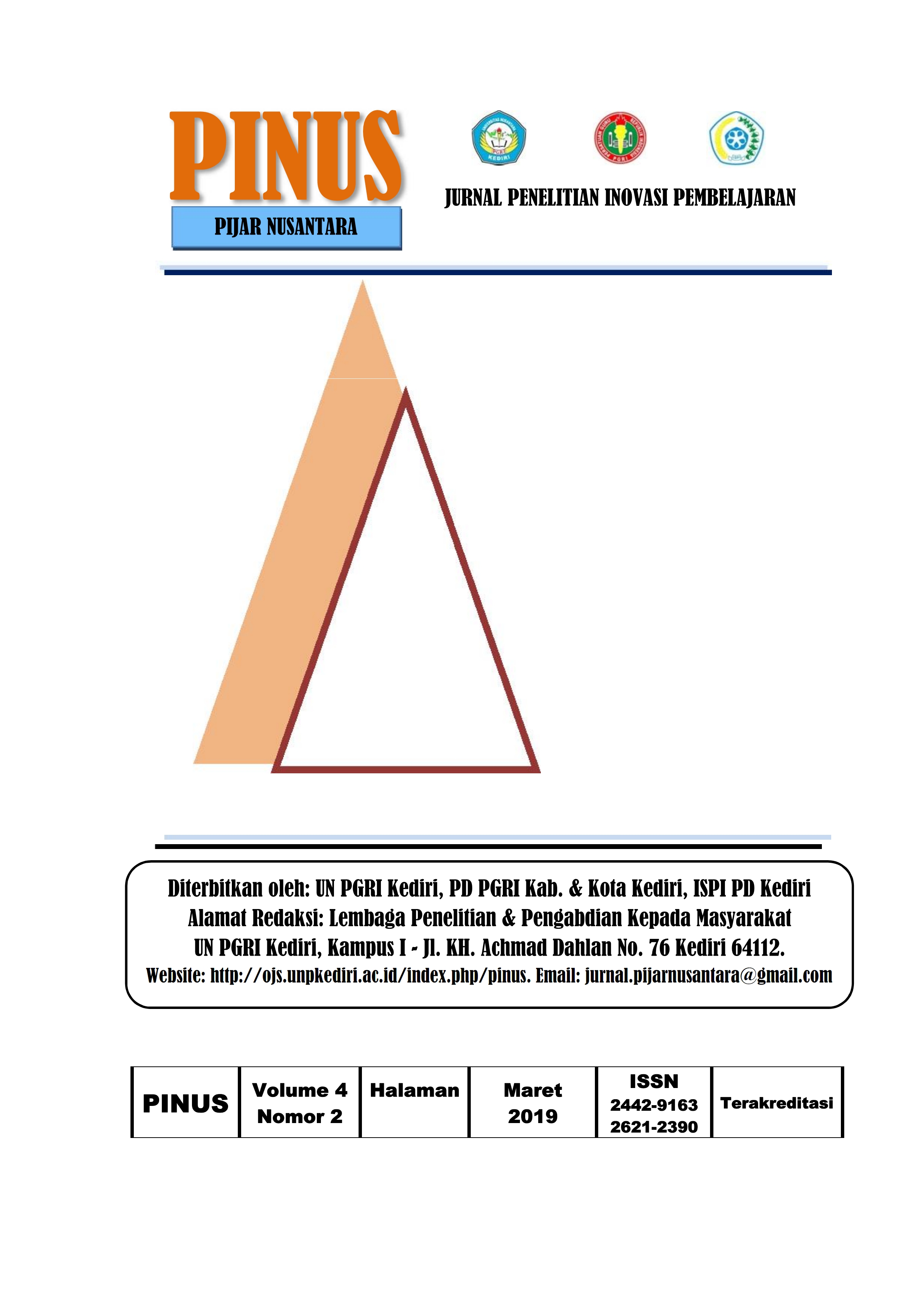Pendidikan Karakter Mata Pelajaran Seni Budaya Melalui Media Wayang Kulit Purwa
Kajian Persepsi Guru-Guru SMP Seni Budaya di Wilayah Solo Raya
DOI:
https://doi.org/10.29407/pn.v4i2.12527Keywords:
Media, Shadow Puppets, Values, Character Education, Arts And Culture TeachersAbstract
This study reveals the cultural arts of teachers on local media shadow pupils to instill character values through learning arts and culture in junior high schools in the Solo Raya region. During this time, pure shadow pupils were only used as public performances outside formal such as junior high school institutions. While the teachers in instilling the value of character education through teaching are still limited to formal tools. This research has its own specificity because of the use of the wayang kulit media. This research was carried out by a number of teachers in the entire city of Solo, which covered 7 (seven) regencies/municipalities. The technique for collecting data is done by questionnaires and interviews. To analyze the data using the initial steps of data collection, data reduction, data presentation, and drawing conclusions. The results showed that most of the cultural teachers had positive learning from students in junior high school. However, most people who have an undergraduate education are positive perceptions. Because the wayang kulit purwa has the contents of moral values, social culture, character education and love for the motherland.
Downloads
References
Arifin, F. (2013). Wayang Kulit Sebagai Media Pendidikan Budi Pekerti. Jantra : Jurnal Sejarah dan Budaya, 655-733.
Boeriswati, Endry. 2013. Using sponge puppet strategies to instill characters through storytelling to elementary school students in Bekasi. Prosiding Internasional Seminar on Quality and Affordable Education (ISQAE 2013).410-413
Cultrera, A.K., dkk. 2012. Teaching visual arts in parimary school teching departments with postmodern art education approach. Procidia – Social and Behavioral Sciences, 51 (2012) 1044-1049
Fardus. 2010. “Model Pendidikan Nilai Sosial Budaya dalam Keluarga dan Lingkungan Manusia Bajo di Bajoe”. Educationist. 4 (1) 57-66
Furkan, Nuril. 2014. The implementation of Character Education through the School Culture in SmaNegeri 1 Dompu and SmaNegeriKlioDompu Regency. Journal of Literature, Languages and Linguistics, 3 (2) 14-44
Ghani, D.A., Ishak, S.B.A. 2012. Relationship between the art of WayangKulit and disney’s twelve principles of animation. Revista de cercetaresiinterventiesociala, 37 162-179
Hariyanto, W.E. 2014. “Penerapan Media Pembelajaran Seni Rupa Berbasis Audio Visual pada Materi Batik Siswa Kelas VIII C SMP Negeri I Turi Lamongan”. Jurnal Pendidikan Seni Rupa, 2 (3)134-138
Hatzigiani, M., Miller, M. G., &Quiňones, G. 2016. Karagiozis in Australia: Exploring principles of social justice in the arts foe young children. Internasional Journal of Education & the Art, 17 (25) 1-20
Hidajat, Robby. 2015. The Symbolic Meaning of the Role of the WayangTopeng in Malang, East Java, Indonesia. IMPACT: International Journal of research in Humanities, Arst and Literature. 3 (8) 21-28
Kim, Deokman. 2015. “A Study on the class of education that builds students’ character through film – classes at the university of liberal arts”. Procedia INTE 2014. Social and Behavioral Sciences 174 (2015) 1529 – 1533.
Koo, Ahran. 2015. “Art and eduation for underprivileged people: Community-based art projects case study”. Procedia – Social Behavioral Sciences 174 (2015) 64-68
Kusrina. 2007. “Dampak Tayangan Lagu Anak-anak di Televisi pada Pendidikan Seni di Sekolah”. Harmonia Jurnal Pengetahuan dan Pemikiran Seni. 30 (2) 148-156
Mas, S.R. 2008. “Profesionalitas Guru dalam Meningkatkan Kualitas Pembelajaran”. Inovasi. 5 (2) 10-21
Mils, M.B & Huberman A.M. 1984. Analisis Data Kualitatif. Terjemehan oleh Tjetjep Rohendi Rohidi. 1992. Jakarta: Penerbit Universitas Indonesia
Mulyana, 2006. Spiritualisme Jawa: Meraba Demensi dan PergulatanReligiousitas Orang Jawa. Kejawen, 1 (2) 62-78
Nurgiyanto, B. (2011). Wayang dan Pengembangan Karakter Bangsa. Jurnal Pendidikan Karakter, 1 (1) 18-34
Nurrochsyam, M. W., 2014. Caracter Building: Interpretation of Nationalism in Wayang. Jantra, 9 (2) 151-159
Pavlou, Victoria. 2003. “Investigating Interrelations in Visual Arts Education Aesthetic Enquiry, Possibility Thinking and Creativity” International journal of Education Through Art, 9 (1) 71-88
Potgieter, A., Brits, J.S., & Potgieter, M.J. 2014. Exploring the of Puppet Shows in Presenting Nano Technology Lessons in Early Childhood Education. International Journal for Crose-Disciplinary Subjects in Education (IJCDSE), 5 (1) 1798-1803
Ramdhani, M.A. 2014. “Lingkungan Pendidikan dalam Implementasi Pendidikan Karakter”. Jurnal Pendidikan Universitas Garut. 8 (1) 28-37
Rosala, D. 2016. “Pembelajaran Seni Budaya Berbasis Kearifan Lokal dalam Upaya Membangun Pendidikan Karakter Siswa di Sekolah Dasar”. Jurnal Ritme, 2 (1) 17-26
Sanjaya, W. (2014). Strategi Pembelajaran Berorientasi Standart Proses Pendidikan. Jakarta : Prenada Media Grup
Santoso, T. (2010). Wayang Mendidik Tanpa Menggurui. Lango: Jurnal Seni Tiga Rembulan, 5 (3) 16-21.
Solikhudin, F. 2016. “Pelaksanaan Pembelajaran Seni Budaya Berdasarkan Kurikulum Tingkat Satuan Pendidikan di SMP Wachid Hasim 9 Sehati, Sidoharjo”. Jurnal Pendidikan Seni Rupa. 4 (1) 129-135
Subiyantoro, Slamet. 2017. The Learning of Arts and Cultures in the Farm Field School for the Illegal Indonesian Migrant Workers’ Children: A Chase Study form Community Learning Center (CLC) at Sabah, Malaysia. Prociding Advances in Science, Education and humanities Research (ASSEHR), Volume 158 halaman 783-791
Sutiyono. 2014. The Art of Pupperity: a Meduim to Develop The Socialization And Cultivation of Educational Values on Nationalism. Jentra, 9 (2) 161-171
Sultoni, A. 2016. “Pendidikan Karakter dan Kemajuan Negara: Studi Perbandigan Lintas Negara”. Journal of Islamic Education Studies. 1 (1) 184-207
Yabu M. “Model Pembelajaran Seni Budaya Berbasis Pendekatan Infiltrasi Pendidikan intas Kultur dalam Upaya Pemebentukan Karakter Peserta Didik” dalam Prosiding Seminar Nasional Pendidikan Seni Fak Sni dan Desain UNM. H 216-224
Yuen, Celeste Y.M. 2016. “Linking life satisfaction with school engagement of secondary students from diverse cultural backgrounds in Hong Kong”.International Journal of educational Reserch. 77 (2016) 74-82
Zulkarnain. 2016. “Pengembangan Bahan Belajar Budaya Lokal Sebagai Pendidikan Informal dalam Membina Kerukunan Pada Pembelajaran Program Kejar Paket B”. Jurnal Pendidikan Non Formal, 10 (2) 63 – 71
Published
Issue
Section
License
Authors who publish with this journal agree to the following terms:
- Copyright on any article is retained by the author(s).
- The author grants the journal, right of first publication with the work simultaneously licensed under a Creative Commons Attribution License that allows others to share the work with an acknowledgment of the work’s authorship and initial publication in this journal.
- Authors are able to enter into separate, additional contractual arrangements for the non-exclusive distribution of the journal’s published version of the work (e.g., post it to an institutional repository or publish it in a book), with an acknowledgment of its initial publication in this journal.
- Authors are permitted and encouraged to post their work online (e.g., in institutional repositories or on their website) prior to and during the submission process, as it can lead to productive exchanges, as well as earlier and greater citation of published work.
- The article and any associated published material is distributed under the Creative Commons Attribution-ShareAlike 4.0 International License









